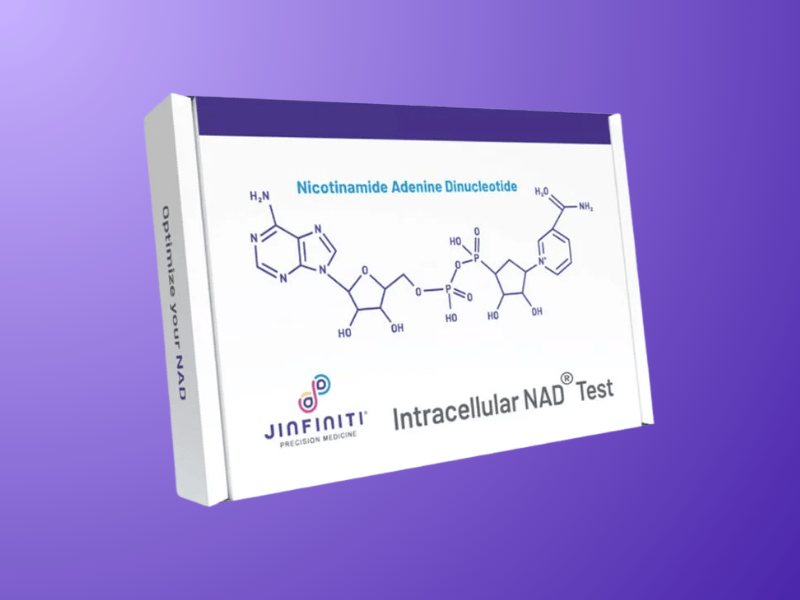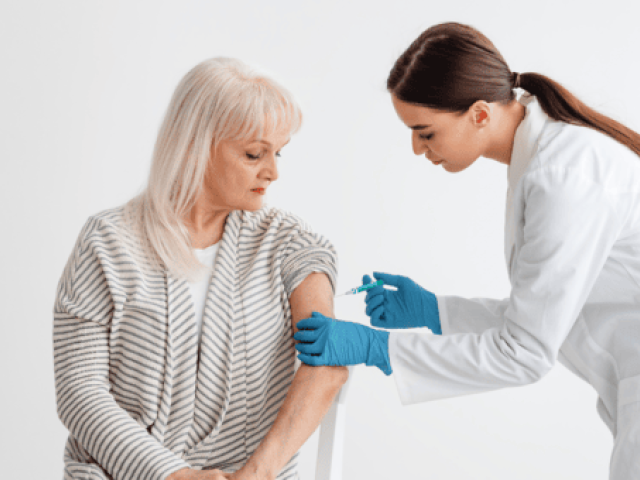
NAD Injections vs. Oral NAD Supplements: How Do They Compare?
When choosing between NAD injections and oral supplements, the research is clear. Oral NAD precursors like NMN and NR are supported by robust clinical trials showing they safely increase intracellular NAD+ levels.
Injectable NAD+, despite higher bioavailability claims, faces skepticism from leading researchers who question whether it actually enters cells or simply breaks down into other compounds.
Quick Takeaways
- Oral NMN and NR supplements are backed by multiple randomized controlled trials showing they safely increase NAD levels inside cells
- Leading longevity researchers question whether injectable NAD+ actually enters cells, as the molecule may be too large and breaks down before reaching cellular targets
- Injectable NAD+ costs 3-10x more than oral supplements ($100-700 monthly vs. $30-80 monthly) with less scientific evidence
- Testing your NAD levels before and after supplementation is the only way to know if your chosen method actually works for your body
Understanding NAD+ and Why It Matters
NAD+ (Nicotinamide Adenine Dinucleotide) serves as a coenzyme in every cell of your body. It powers hundreds of metabolic reactions, from energy production to DNA repair.
Your NAD levels decline dramatically with age. Research shows levels drop in a number of tissues as a function of aging and overnutrition[1].
This decline contributes to the symptoms many people associate with aging: fatigue, brain fog, and reduced physical recovery. You can see why NAD+ supplementation has become a focal point in longevity medicine.
A Critical Difference: NAD+ vs. NAD+ Precursors
Before comparing delivery methods, you need to understand what you’re actually taking.
- Direct NAD+ (in injections/IV): The actual NAD+ molecule injected into your bloodstream or muscle tissue.
- NAD+ Precursors (in oral supplements): Compounds like NMN (Nicotinamide Mononucleotide) and NR (Nicotinamide Riboside) that your body converts into NAD+.
This distinction matters more than most marketing materials let on.
What Researchers Say About NAD Injections vs Pills
Dr. Eric Verdin, President of the Buck Institute for Research on Aging, stated clearly: “My opinion is that NAD+ intravenously is not something that should be done… NAD+ is too big to enter cells and is mostly broken down into nicotinamide when injected. Oral precursors like NMN or NR are a better bet for most people.”
This isn’t a minor technical detail. If injected NAD+ can’t enter your cells, it doesn’t matter how high the bioavailability appears on paper.
This challenges a common assumption that injectable NAD+ is automatically more effective than oral forms simply because absorption rates look better.
Dr. Amanda Kahn, a board-certified internist, offers a different perspective. She notes that NAD+ injections “give you back a molecule that you had when you were younger, which is responsible for keeping the cells optimized, particularly the mitochondria.”
The disagreement among experts reveals the current state of the science: promising anecdotal reports but limited rigorous research.

Comparing Absorption and Bioavailability
Let’s look at what actually happens when you take NAD+ through different routes.
| Delivery Method | Absorption Rate | Time to Effect | Clinical Evidence Level |
|---|---|---|---|
| Oral NR/NMN | 10-20% average | 2-4 weeks | High (multiple RCTs) |
| IM/SubQ Injection | 70-80% claimed | Days | Low (case reports) |
| IV Therapy | Up to 100% claimed | Immediate | Low (observational) |
Clinical trials with oral NR have demonstrated 22-142% increases in blood NAD+ levels after 2-4 weeks of supplementation[2]. These studies followed rigorous protocols with placebo controls.
Injectable NAD+ shows higher absorption rates in theory. But here’s the catch: higher blood levels don’t automatically mean higher intracellular levels where NAD+ actually does its work.
It’s worth noting that no FDA-approved protocols exist for NAD+ injections. Current dosage regimens are based on clinical experience and expert consensus, not large-scale trials.
Full Comparison: Injections vs. IV vs. Oral NAD Supplements
Looking at all three NAD therapy delivery methods side by side reveals important practical differences.
| Feature | Oral Supplements (NMN/NR) | Injections (IM/SubQ) | NAD IV Therapy (Infusion) |
|---|---|---|---|
| Absorption | Low-Moderate (2-60%) | Very High (70-80%) | Maximum (~100%) |
| Time to Effect | Weeks | Hours-Days | Minutes-Hours |
| Convenience | Most convenient | Self-administered, quick | Requires clinic visit |
| Cost | Low ($30-80/month) | Mid-High ($100-500/month) | High ($250-700/session) |
| Use Case | Long-term maintenance | Regular support, faster results | Acute needs, medical protocols |
| Expert Consensus | Sufficient for most, safest | High blood levels, cellular uptake unclear | Most potent delivery, limited evidence |
The myth that “more is always better” doesn’t hold up. Exceeding recommended doses can risk adverse effects, and higher doses don’t guarantee better long-term results. Your body has limits on how much NAD+ it can use at once.
The Evidence for Oral NAD+ Precursors
Multiple peer-reviewed studies support oral NMN and NR supplementation.
Research published in Nature Communications showed that oral NR safely increased NAD+ metabolites in humans[2]. Another study in NPJ Aging found NMN was well-tolerated up to 2,000 mg daily[3].
These aren’t small pilot studies. They’re randomized, double-blind, placebo-controlled trials with measurable outcomes.
The clinical benefits documented include:
- Improved cardiovascular markers[4]
- Better metabolic function[5]
- Enhanced cellular energy production[6]
- Support for healthy aging processes[7]
The Evidence Gap for NAD+ Injections

Injectable NAD+ therapy has a different evidence profile. Most supporting data comes from case reports and observational studies, not controlled trials.
One systematic review noted that most evidence focuses on raising NAD+ levels, not long-term disease outcomes[8].
While injections may increase blood NAD+ measurements, proven reductions in disease rates or significant anti-aging effects in humans remain less robust.
The research that does exist for injectable NAD+ centers on addiction treatment. Studies suggest high-dose IV NAD+ may help with withdrawal symptoms[9], but these protocols differ significantly from wellness applications and should only be used under medical supervision.
No large-scale clinical trials have demonstrated that NAD+ injections increase intracellular NAD+ levels more than oral precursors.
Safety Profiles and Side Effects
Oral Supplements
Clinical trials show oral NMN and NR are remarkably safe[6]. Side effects are rare and mild, typically limited to:
- Mild nausea (uncommon)
- Flushing (rare)
- Digestive discomfort (minimal)
Doses up to 2,000 mg daily have been tested without serious adverse events[3].
Injectable NAD+
Injections carry different risks:
- Injection site reactions (pain, bruising)
- Lightheadedness during or after administration
- Nausea if administered too quickly
- Rare allergic reactions
- Risk of infection with improper technique
Standard operating procedures for NAD+ injections emphasize medical supervision precisely because of these concerns.
Cost Comparison
Money matters when you’re making a long-term health investment.
- Oral NMN/NR Supplements: $30-80 per month for quality products
- NAD+ Injections: $100-500 per month depending on frequency
- IV Therapy: $250-700 per session
If you’re planning to supplement long-term (which makes sense for age-related NAD+ decline), oral supplements offer better value.
Testing: The Missing Piece Most People Ignore
Dr. Jin-Xiong She, founder of Jinfiniti Precision Medicine and a genomic scientist with over 400 peer-reviewed publications, emphasizes a point most people overlook.
“You cannot optimize what you don’t measure. NAD+ levels vary dramatically between individuals, and the same dose of any supplement could be optimal for one person, ineffective for another, or even excessive for a third. Testing is the only way to know if your intervention is working.”
This applies whether you choose injections or oral supplements.
Jinfiniti’s Intracellular NAD+ Test measures your actual cellular NAD+ levels, not just blood markers. According to Dr. She’s clinical research, optimal levels fall between 40-100 μM.
Without testing, you’re making expensive guesses about what your body needs.
When Injections Might Make Sense
To be fair, injectable NAD+ isn’t without its uses.
Some situations where injections may be considered:
- Severe malabsorption issues preventing oral supplement absorption
- Acute situations requiring rapid intervention (under medical supervision)
- As part of addiction treatment protocols in clinical settings
- When oral supplementation has been tried and tested without results
Even in these cases, medical supervision is recommended.
It’s a common misconception that only older adults benefit from NAD+ support. While age-related decline is well-documented, younger individuals under chronic stress, in recovery from illness, or with low baseline NAD+ levels may also see benefits. The magnitude of effect may differ, but NAD+ optimization isn’t exclusively for aging populations.
Natural Ways to Support NAD+ Production
Supplements aren’t your only option. Lifestyle factors significantly impact NAD+ levels.
- Exercise stimulates NAD+ production through metabolic stress[10]. Both aerobic and resistance training show benefits.
- Intermittent fasting activates cellular pathways that preserve NAD+. Research suggests fasting periods trigger NAD+ conservation mechanisms[11].
- Sleep quality affects NAD+ metabolism. Poor sleep disrupts circadian rhythms that regulate NAD+ synthesis[12].
Foods high in NAD+ precursors include fish, turkey, mushrooms, and green vegetables. While diet alone won’t fully compensate for age-related decline, it provides foundational support.
The Bottom Line
The scientific consensus leans toward oral NAD+ precursors for most people.
NMN and NR have robust clinical evidence showing they safely increase NAD+ levels. They’re convenient, cost-effective, and well-studied.
Injectable NAD+ may deliver higher blood concentrations, but leading researchers question whether it effectively enters cells. The lack of controlled trials comparing intracellular NAD+ levels after injection versus oral supplementation leaves a significant evidence gap.
For addiction treatment under medical supervision, high-dose IV protocols may have a role. For general wellness and longevity, the data supports oral precursors.
Which Should You Choose?
Consider these factors:
Choose oral supplements if you:
- Want the best-researched option
- Prefer convenience and lower cost
- Are focused on long-term wellness
- Can commit to consistent daily use
Consider injections if you:
- Have documented severe malabsorption
- Are working with a qualified physician on acute issues
- Have tried oral supplements with testing confirmation of no response
- Accept higher costs for potentially faster results
How to Safely Start Taking NAD
Start with testing your baseline NAD levels to remove the guesswork from supplementation.
If you choose oral supplements, select high-quality NMN or NR from reputable manufacturers. Look for third-party testing and pharmaceutical-grade production.
Retest after 4-6 weeks to confirm your protocol is working. Adjust dosing based on results, not marketing promises.
If you’re considering injections, work with a licensed healthcare provider who can monitor your response and watch for adverse effects.
Remember that NAD+ optimization works best as part of a comprehensive approach including exercise, nutrition, sleep, and stress management.
The goal isn’t just to raise a number on a test. It’s to support your body’s cellular function so you can maintain energy, mental clarity, and physical vitality as you age.
Ready to measure your NAD+ levels and start optimizing? Jinfiniti’s NAD Optimization® Starter Package includes testing and our scientifically formulated Vitality NAD+ Booster to help you achieve optimal cellular health.
Referenced Sources
- Verdin E. NAD+ in aging, metabolism, and neurodegeneration. American Association for the Advancement of Science (AAAS); 2015. https://doi.org/10.1126/science.aac4854
- Martens CR, Denman BA, Mazzo MR, Armstrong ML, Reisdorph N, McQueen MB, et al. Chronic nicotinamide riboside supplementation is well-tolerated and elevates NAD+ in healthy middle-aged and older adults. Springer Science and Business Media LLC; 2018. https://doi.org/10.1038/s41467-018-03421-7
- Henderson JD, Quigley SNZ, Chachra SS, Conlon N, Ford D. The use of a systems approach to increase NAD+ in human participants. Springer Science and Business Media LLC; 2024. https://doi.org/10.1038/s41514-023-00134-0
- Vreones M, Mustapic M, Moaddel R, Pucha KA, Lovett J, Seals DR, et al. Oral nicotinamide riboside raises NAD+ and lowers biomarkers of neurodegenerative pathology in plasma extracellular vesicles enriched for neuronal origin. Wiley; 2022. https://doi.org/10.1111/acel.13754
- She J, Sheng R, Qin ZH. Pharmacology and Potential Implications of Nicotinamide Adenine Dinucleotide Precursors. Aging and Disease; 2021. https://doi.org/10.14336/ad.2021.0523
- Yi L, Maier AB, Tao R, Lin Z, Vaidya A, Pendse S, et al. The efficacy and safety of β-nicotinamide mononucleotide (NMN) supplementation in healthy middle-aged adults: a randomized, multicenter, double-blind, placebo-controlled, parallel-group, dose-dependent clinical trial. Springer Science and Business Media LLC; 2022. https://doi.org/10.1007/s11357-022-00705-1
- Conlon NJ. The Role of NAD+ in Regenerative Medicine. Ovid Technologies (Wolters Kluwer Health); 2021. https://doi.org/10.1097/prs.0000000000009673
- Freeberg KA, Udovich CC, Martens CR, Seals DR, Craighead DH. Dietary Supplementation With NAD+-Boosting Compounds in Humans: Current Knowledge and Future Directions. Oxford University Press (OUP); 2023. https://doi.org/10.1093/gerona/glad106
- Braidy N, Villalva MD, Eeden S van. Sobriety and Satiety: Is NAD+ the Answer?. MDPI AG; 2020. https://doi.org/10.3390/antiox9050425
- Walzik D, Joisten N, Schenk A, Trebing S, Schaaf K, Metcalfe AJ, et al. Acute exercise boosts NAD+ metabolism of human peripheral blood mononuclear cells. Elsevier BV; 2025. https://doi.org/10.1016/j.bbi.2024.11.004
- Poljsak B, Kovač V, Milisav I. Healthy Lifestyle Recommendations: Do the Beneficial Effects Originate from NAD+ Amount at the Cellular Level?. Wiley; 2020. https://doi.org/10.1155/2020/8819627
- Cuenoud B, Huang Z, Hartweg M, Widmaier M, Lim SongI, Wenz D, et al. Effect of circadian rhythm on NAD and other metabolites in human brain. Frontiers Media SA; 2023. https://doi.org/10.3389/fphys.2023.1285776

Get weekly health insights and exclusive offers by joining our newsletter.










